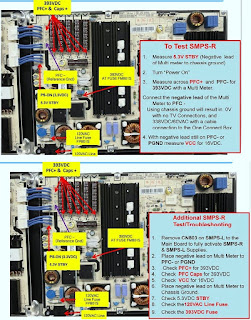 Samsung OLED TV - SMPS troubleshooting
Samsung OLED TV - SMPS troubleshooting
How to troubleshoot the power supply regulator board (SMPS board) - Samsung OLED TV.
A
cable connection from the MOIP to the Main Board. The EL Board connections are
made to the L & R Panel Ribbon Cables located on each side of the Panel.
The EL Board also connects directly to the left SMPS for its voltages supply.
The SMPS Right connects to the SMPS Left while the SMPS Left connects also to
the Main Board with the CN803 connector. The Sub Woofer also connects directly
to the Main Board as well as the Jog Function, Wi-Fi Module, Speakers, IR, Eco
Sensor (not shown) and Bluetooth Module.
The
ECO Sensor, PWR Status LED, & IR Sensor are on a Board located behind the
Front Bottom Centre Grill of the OLED TV Frame. The 7 pin connector
originating it’s signals from the Main board is shown and includes 1.8VD C to
the LED Power Stdby indicator found on Pin 2, Data Signals on pin 3 & 4 that
can be measured as effective pulsating DC 3.3VDC to 3.1VDC, A 3.3Vdc Supply on
pin 5, and an IR Data Sig. measuring 3.3VDC and 2.7VDC with a re mote control
command. The 3 Pin Jog Shuttle will
measure 3.3V on both Key 1 & Key 2 without any commands and OV on Key 1
with the Power & Enter Press Command Button. Key 2 will change from 3.3VDC
to 1.6VDC with Plus Command. 2.5VDC with Minus, 0V with Up, and .8VDC with the
Down command.
The
SMPS Right Power Supply is responsible for producing a 393VDC PFC Supply ld
16V C VCC S l f h SM S L f d d 3V voltage and a 16VDC VCC Supply for the SMPS
Left Board and a 5.3V DC STBY for the Main Board. A PFC or Power Factor Control
Circuit is used to control the voltages regardless of line voltage fluctuations
while also preventing any power related harmonic noise. It will also increase
the efficiency of the Power Supplies resulting in less power consumption to
operate.
To Test SMPS-R
1. The SMPS Left Power Supply Board receives the PFC, VCC & STBY Supply Voltages from the SMPS- R Board.
2. Receives PS-ON from Main Board
3. Sends PS-ON to SMPS-R
4. Produces 12VDC Supply for the Main Board
5. Produces
24VDC Supply for the EL Board. The 24VDC Circuit Detect and 24V Supply
Filter Caps are provided near the top section of the Board. A similar
12VDC Circuit is located near the bottom of the Board. The PFC+ &
PFC Minus (P GND Reference) enters in at the top right 5 Pin Connector.
Two PFC Fuses are also located near the top right and bottom centre of
the Board.
To
Test SMPS-L
Additional
SMPS-L Test
1. Locate & Check the two 393VDC Fuses located near top right and bottom center of the board
2. Check 24VDC at the two Regulators and carefully measure the 24VDC at the Supply’s Filter Capacitors 3. Check 12VDC at the two Regulators.
1. Locate & Check the two 393VDC Fuses located near top right and bottom center of the board
2. Check 24VDC at the two Regulators and carefully measure the 24VDC at the Supply’s Filter Capacitors 3. Check 12VDC at the two Regulators.





